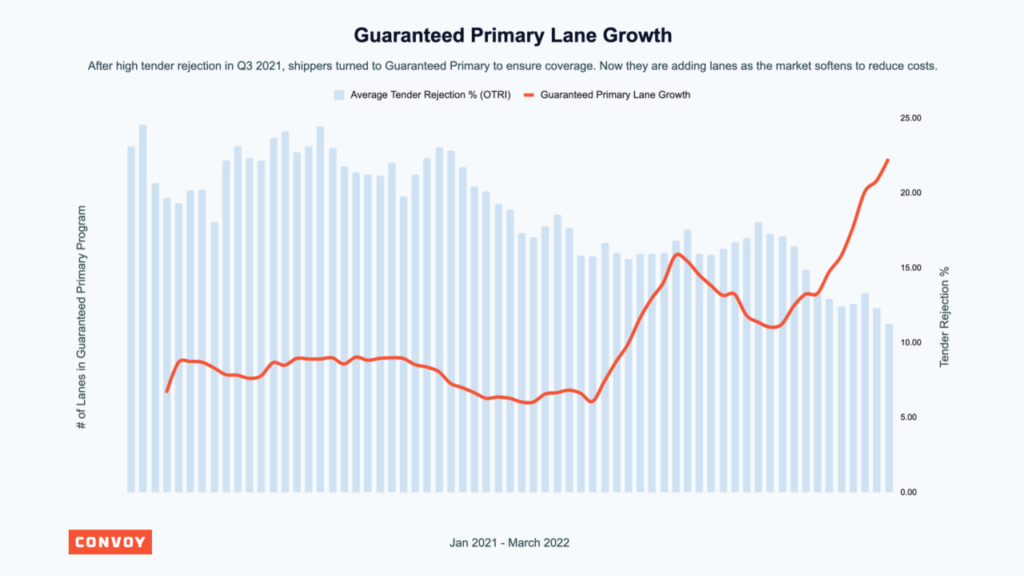5 Ways Dynamic Contract Pricing is Helping Shippers
Shippers • Published on April 11, 2022
Volatility is here to stay, and so is dynamic contract pricing. 18 months into our journey with Guaranteed Primary, we’re seeing how it can improve service, reduce costs, and eliminate a lot of frustration for our customers. Here’s what I’ve learned, and where we’re headed next.
a significant challenge for the freight industry has always been having contract pricing tool for freight RFPs because neither party, the shipper or the carrier/broker, is financially obligated to deliver on what was agreed to at the time of the contract. This lack of obligation occurs because shippers can’t perfectly predict the number of loads they will need to move when, and carriers and brokers can’t predict truck and labor prices. COVID provided a perfect example of this challenge.
Volatility in Freight Contract Pricing
When COVID first hit, truck rates were highly volatile as consumers stockpiled goods and different states and sectors of the economy turned off and on again. Then, rates increased rapidly for over a year, causing many of these annually contracted truck rates to become outdated. Some of these contracts began to unravel – shippers needed more capacity in different places than they had forecast and trucking carriers and brokers either struggled to find capacity at the contracted rates or opportunistically went after the then-current higher rates. Having seen this pattern in other boom and bust freight cycles, Convoy created a new type of contract pricing program to handle volatility without compromising service.
Dynamic Contract Pricing for Freight Shippers
Guaranteed Primary launched in September 2020, allowing our customers to participate in a dynamically priced contract agreement that guaranteed tender acceptance. The first program of its kind, it also enables users to see rates at the shipment level before tendering through a predictive pricing algorithm and provides complete transparency into our costs every month through reports and business reviews.
To say this caught the industry’s attention is an understatement. One of our employees’ LinkedIn posts about this innovation became the epicenter of an industry debate on how to approach the problem. Many 3PLs and carriers were skeptical that it could work or be better than the status quo. However, many others saw something they liked.
It turns out that both were correct.
Dynamic Contract Pricing Solves Different Problems with the Freight Industry’s Traditional RFP Process
Freight is complicated. Each shipper, each lane, and each market condition present different problems that can be solved with different types of contract pricing. In some situations, Guaranteed Primary wasn’t the best fit, but it turned out that in many situations it was. The first set of shippers to adopt the new program were urgently trying to find stable trucking support, and Guaranteed Primary offered an efficient solution. Many others also wanted to secure a contract that would adjust down as the market softened, as it is doing today. Here’s what we’ve seen so far:
- 18 months after launch, every customer we’ve onboarded to the program is still using it today.
- When the industry tender rejection rate hovered around 25% in Q3 2021, Convoy accepted 99.997% of Guaranteed Primary loads.
- Demand is accelerating for the program from both new and existing customers – with load volume nearly quadrupling and the number of lanes serviced doubling in the last year.
- Guaranteed Primary is an excellent fit for shippers with high rejection rates, low safety stock, out-of-stock, and just-in-time manufacturing or inventory scenarios – especially in tight markets.

Over the past year, I’ve spoken with several Guaranteed Primary customers to better understand their experience.
Benefits of Dynamic Pricing vs. Contract Pricing
- Dynamic contract pricing drastically improves service levels and helps avoid out-of-stock scenarios. One of our large retail customers struggled to keep their products in stock, with a typical tender acceptance on surge freight at 15%. When they began utilizing Guaranteed Primary, tender acceptance shot up to 100%, allowing them to realize millions of dollars in revenue by keeping shelves stocked. Additionally, they saw on-time pickup improve from 14% to 86% when combined with our drop program.
- Digital freight networks deliver excellent coverage for low lead time freight. Some of our customers don’t have the luxury of advanced planning due to their supply chain operations. Despite having an average lead time of only 24 business hours, we eliminated the need for spot and service over 350 problematic lanes for a multinational auto manufacturer. They were previously experiencing rejection rates of up to 30%. But with our elastic carrier network, we have covered 100% of loads while meeting the strict OTP/OTD requirements inherent with the coordinated relay/handoff nature of just-in-time manufacturing.
- Everyone benefits from transparency, fair prices, and guaranteed capacity. When the market swings after the ink has dried, traditional contracts result in a winner and a loser – one reason why they’re so often broken. By providing transparent reporting and detailed reviews with our customers, we can grow a healthy business with positive margins, provide a fair price to our shippers without the hassle of tender rejections from broken contracts, and keep our carriers earning competitive wages.
- Cost savings for shippers are real, even in tight markets. Our customers have done the math. They’ve compared our rates to industry averages at the lane and shipment level, and we’ve been able to save them money in real-world scenarios. One customer recently told me they’d saved 16% in truck costs with Guaranteed Primary and an estimated $90,000 savings on administrative costs by avoiding the spot market.
- A new set of award criteria is emerging. Previously, shippers haven’t had easy access to additional data to evaluate incumbent providers against new providers. It’s been a game of “the asset or broker you know vs. the one you don’t,” but that isn’t the case anymore. As technology becomes a core part of the industry, shippers can pinpoint areas that matter most to their business: where our network has the strongest overlap, our performance on lanes and facilities they ship into and out of (or similar), and where they are best served with traditional contracts vs. dynamic pricing, as well as live or drop. I am grateful that our technology can support these asks and speed award decisions as we partner with our shippers to become more efficient in planning cycles.
Overall, we see positive shifts in the market, indicating a collective effort to modernize contract freight. Mini-bids are more common. Technology is making traditional RFP processes less cumbersome and manual. We’ve even seen other players evolve existing cost-plus programs to more closely mirror what we created. I believe we’ll soon see dynamic contract pricing programs take substantial volume out of the spot and traditional contract markets to create more balanced portfolios that benefit all players.
Today our customers are putting more volume into Guaranteed Primary, anticipating even more cost savings as the market softens. They’ve also told us the service improvements alone were enough reason to make the switch. We’re still in the early days of this monumental shift, but I’m excited as ever about the opportunity and the road ahead.



